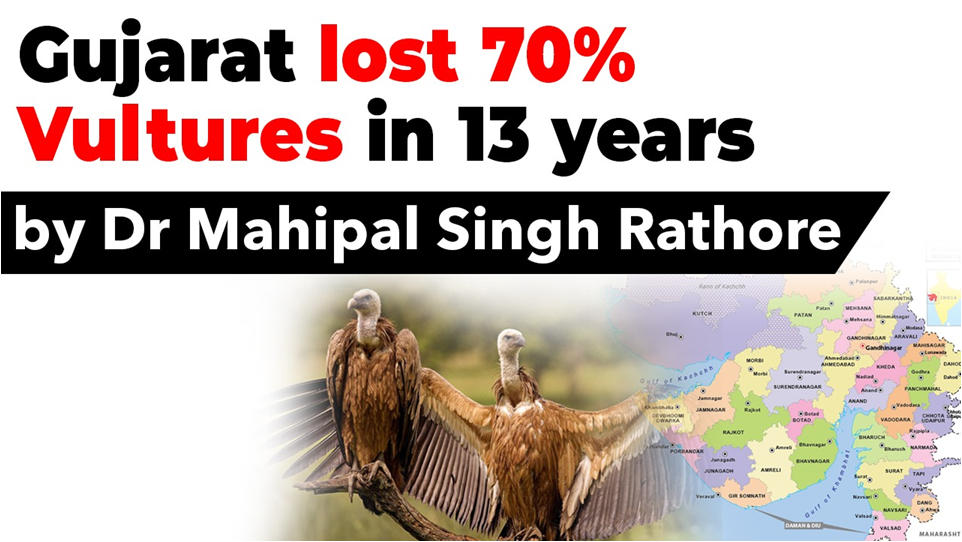Table of Contents
Why in news?
- The number of Gyps vultures in Gujarat has plummeted, Union Minister of State, Ministry of Environment, Forest and Climate Change (MoEF&CC), Babul Supriyo told the Lok Sabha in a written reply .
- The most recent vulture population estimation in Gujarat was carried out in early June 2018.
- A decline of 75.8 per cent in the Gyps vulture population was recorded in the state between 2005 and 2018
- The decrease was marked in most major districts of the state.
- Ahmedabad area recorded an 80 percent decrease in vulture population from 2005 with numbers falling from 254 to 50 in 2018.
- IIM Ahmedabad, one of the biggest vulture colonies in the state, does not have a single vulture remaining, thanks to development work within the campus.
- 2016 census – 999 vultures in the state
- 2018 census – 820 vultures remained
- Thus, between 2016 and 2018, the number declined by 18%.
- The problem of declining vulture populations is not just a problem for Gujarat.
- The vulture population in India has declined by a shocking 99.95 per cent since the 1980s
- 40 million in 1970s
- 19,000 in 2015



Q. Where is the Jatayu Conservation Breeding Centre located?
Which survey was this ?
- The forest department of Gujarat in collaboration with the Gujarat Ecological Education and Research Foundation has been monitoring the populations since 2005
- Nation-wide vulture surveys are carried out by Bombay Natural History Society every four year, sponsored by the MoEF&CC and the Forest Departments of various states since 1990.
- Vultures, like tigers, are highly mobile, and therefore, left-behind nests can lead to incorrect estimation of the bird population
- There are challenges of replication of data in all surveys. The nationwide surveys provide the best measure so we await results from that for a better understanding.
- The surveys are carried out mainly for three species of critically endangered resident Gyps vultures, White-backed Vulture, Long-billed Vulture and Slender-billed Vulture.
- These three species were very common in the country, with an estimated population of 40 million in the early eighties.
- Based on the latest survey carried out in 2015 and the results published in 2017, there were about
- 6,000 White-backed Vultures,
- 12,000 Long-billed Vultures and
- 1,000 Slender-billed Vultures,

Why are vultures declining?
- Vultures have been facing a serious problem with ‘diclofenac’ contamination in animal carcasses, which forms the basis of their sustenance.
- Widespread use of the livestock drug ‘diclofenac’ has been known to be one of the major factors affecting vulture populations in India.
- The drug, used as an anti-inflammatory and analgesic in cattle, is lethal to vultures when they feed on carcasses of livestock which received diclofenac before death.
- Death due to formation of visceral gouts and renal failure has been associated with diclofenac poisoning in vultures.
- Manufacture, sale and distribution of ‘diclofenac’ is banned by the Drugs and Cosmetic Act of the Government of India
- Meloxicam – substitute
- New drugs like nimesulide and ketoprofen are also causing deaths .
- Lack of Open spaces
- Increasing number of high rise buildings
What has the govt done to protect vultures?
- The Protection status of White-backed, Long-Billed and Slender Billed Vultures was upgraded from Schedule IV to Schedule I of the Wild Life (Protection) Act, 1972
- Diclofenac was banned in 2006
- To conserve the remaining population of vultures in the country and also to facilitate the reintroduction of vultures into the wild from Vulture Conservation Breeding Centres (VCBCs), attempts to create Vulture Safe Zones in the areas are being made
Eight identified vulture safe zones in the country are being made including
- Pinjore in Haryana,
- Rajabhatkhawa in West Bengal,
- Majuli Island in Assam,
- Bukswaha in Bundelkhand, Madhya Pradesh,
- Dudhwa National Park
- Katerniaghat Wildlife Sanctuary in Uttar Pradesh,
- Hazaribagh in Jharkhand,
- Central Gujarat and Saurashtra in Gujarat
Latest Burning Issues | Free PDF






















 WhatsApp
WhatsApp